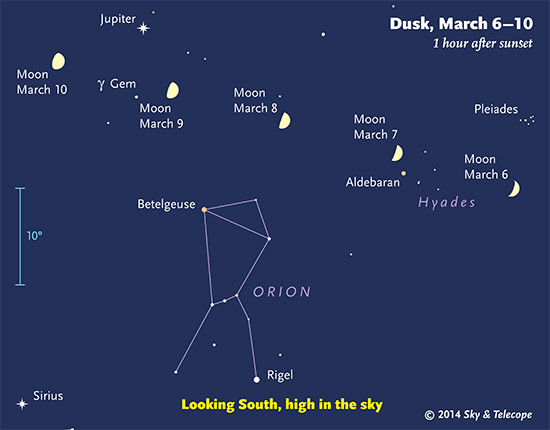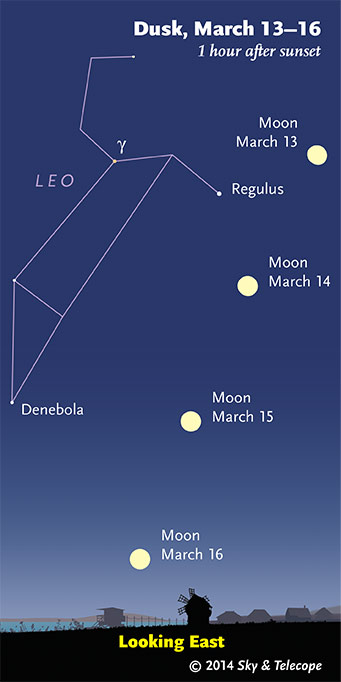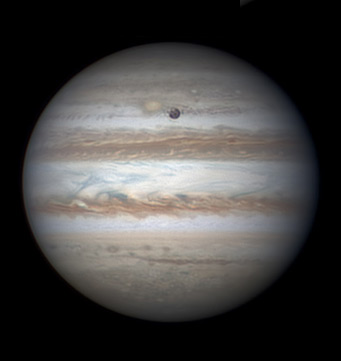
The Moon passes over Orion as it waxes through first quarter. (These scenes are drawn for the middle of North America. European observers: move each Moon symbol a quarter of the way toward the one for the previous date. In the Far East, move it halfway. The blue 10° scale is about the size of your fist held at arm's length.)
.
Friday, March 7
Saturday, March 8
Sunday, March 9
Monday, March 10
Tuesday, March 11
Wednesday, March 12

Leo watches on as the Moon waxes to full. This is the view at dusk as the stars come out.
Thursday, March 13
Friday, March 14
Saturday, March 15
And, you may know that if you follow the curve of the Dipper's handle out and around by a little more than a Dipper length, you'll arc to Arcturus, now rising in the east.
But did you know that if you follow the Pointers backward, you'll land in Leo?
Draw a line diagonally across the Dipper's bowl from where the handle is attached, continue far on, and you'll go to Gemini.
And look at the two stars forming the open top of the Dipper's bowl. Follow this line past the bowl's lip far across the sky, and you crash into Capella.
Want to become a better astronomer? Learn your way around the constellations. They're the key to locating everything fainter and deeper to hunt with binoculars or a telescope.
This is an outdoor nature hobby. For an easy-to-use constellation guide covering the whole evening sky, use the big monthly map in the center of each issue of Sky & Telescope, the essential guide to astronomy. Or download our free Getting Started in Astronomy booklet (which only has bimonthly maps).

The Pocket Sky Atlas plots 30,796 stars to magnitude 7.6 — which may sound like a lot, but that's less than one star in an entire telescopic field of view, on average. By comparison, Sky Atlas 2000.0 plots 81,312 stars to magnitude 8.5, typically one or two stars per telescopic field. Both atlases include many hundreds of deep-sky targets — galaxies, star clusters, and nebulae — to hunt among the stars.
Sky & Telescope
Once you get a telescope, to put it to good use you'll need a detailed, large-scale sky atlas (set of charts). The standards are the little Pocket Sky Atlas, which shows stars to magnitude 7.6; the larger and deeper Sky Atlas 2000.0 (stars to magnitude 8.5); and once you know your way around, the even larger Uranometria 2000.0 (stars to magnitude 9.75). And read how to use sky charts with a telescope.
You'll also want a good deep-sky guidebook, such as Sue French's Deep-Sky Wonders collection (which includes its own charts), Sky Atlas 2000.0 Companion by Strong and Sinnott, the bigger Night Sky Observer's Guide by Kepple and Sanner, or the beloved if dated Burnham's Celestial Handbook.
Can a computerized telescope replace charts? Not for beginners, I don't think, and not on mounts and tripods that are less than top-quality mechanically (able to point with better than 0.2° repeatability, which means fairly heavy and expensive). As Terence Dickinson and Alan Dyer say in their invaluable Backyard Astronomer's Guide, "A full appreciation of the universe cannot come without developing the skills to find things in the sky and understanding how the sky works. This knowledge comes only by spending time under the stars with star maps in hand."
This Week's Planet Roundup

Unlike Jupiter's moons Io and Europa, Ganymede and Callisto are darker than most of Jupiter's surface, as seen dramatically in this high-resolution image of Ganymede near Jupiter's central meridian taken by Christopher Go at 11:20 UT March 2nd. You might even mistake it for its shadow! (The faint light ring that appears inside Ganymede is a processing artifact caused by its sharp dark edge against the lighter background).
South is up. The reddish oval near Ganymede is Oval BA in the South Temperate Zone.
Mercury (magnitude +0.2) is low above the east-southeast horizon during dawn, about 20° lower left of bright Venus.
Venus (magnitude –4.7) shines as the bright "Morning Star" before and during dawn; look southeast.
Mars (magnitude –0.7, in Virgo) rises around 9 p.m., a fiery blaze with icy Spica 5° or 6° to its right. The two are highest in the south around 2 a.m., with Spica now lower right of Mars.
In a telescope Mars has grown to about 12½ arcseconds wide, on its way to an apparent diameter of 15.1″ when it passes closest by Earth in mid-April. See the telescopic Mars map and observing guide in the March Sky & Telescope, page 50.
Jupiter, magnitude –2.4 in Gemini, dominates sky overhead during evening (for midnorthern skywatchers). See our articles on observing Jupiter in the January Sky & Telescope or the briefer online introduction Jupiter: Big, Bright, and Beautiful.
Saturn (magnitude +0.4, in Libra) rises around 11 p.m. and is highest in the south before dawn. By then it's far left of Mars and Spica, and less far to the upper right of Mars-colored Antares.
Uranus and Neptune are lost behind the glare of the Sun.
"We may be little guys, but we don’t think small. It’s the courage of questions, of grasping our true circumstances, and not pretending we are at the center of it all, that is adulthood."
— Ann Druyan, 2014
All descriptions that relate to your horizon — including the words up, down, right, and left — are written for the world's mid-northern latitudes. Descriptions that also depend on longitude (mainly Moon positions) are for North America.
Eastern Standard Time (EST) is Universal Time (UT, UTC, or GMT) minus 5 hours. Eastern Daylight (EDT) is UT minus 4 hours.
Like This Week's Sky at a Glance? Watch our SkyWeek TV short, also playing on PBS.
To be sure to get the current Sky at a Glance, bookmark this URL:
http://SkyandTelescope.com/observing/ataglance?1=1
If pictures fail to load, refresh the page. If they still fail to load, change the 1 at the end of the URL to any other character and try again.
 0
0
Comments
You must be logged in to post a comment.